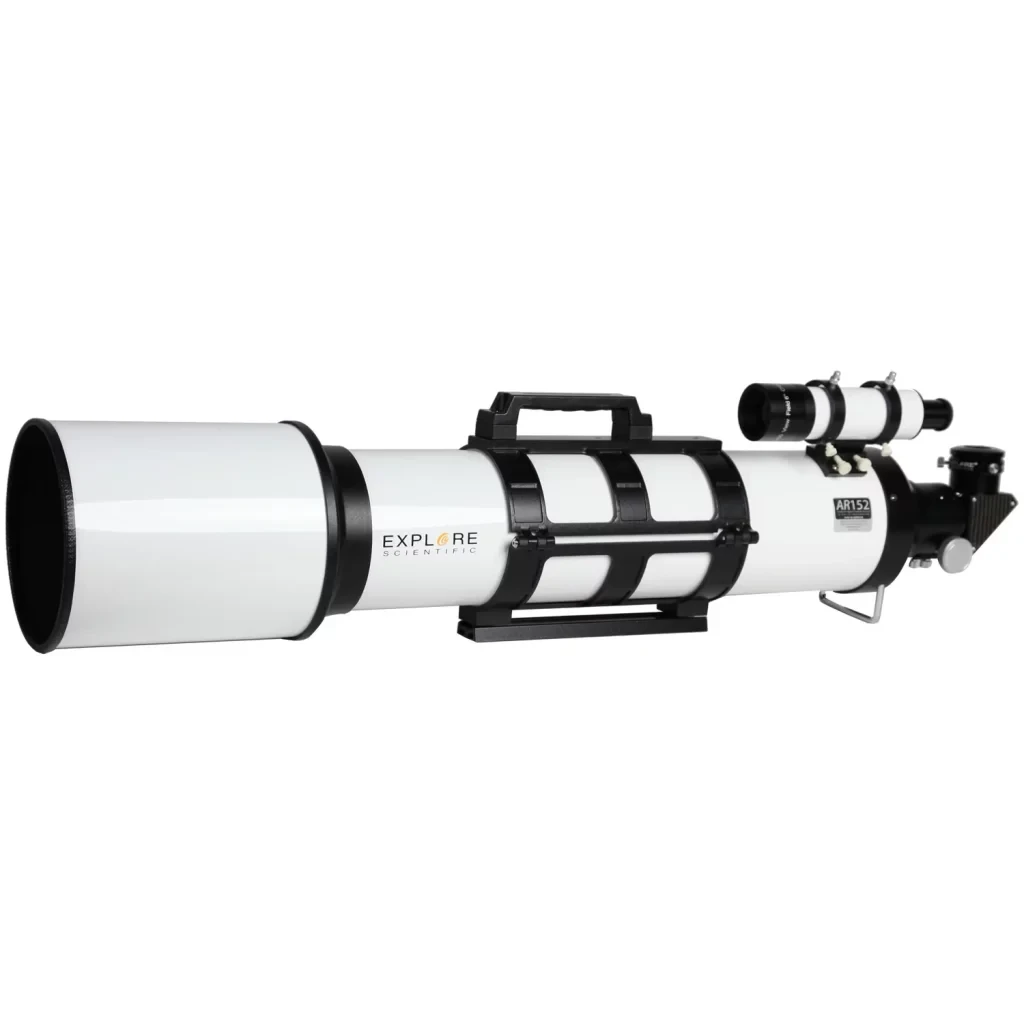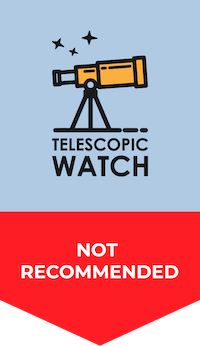Overview
The Explore Scientific AR152 is a 152mm (6”) achromatic doublet refractor with an f/6.5 focal ratio and resulting 988mm focal length. Its Fraunhofer doublet objective is multi-coated and mounted in a lens cell that can be collimated if need be; our collimation guide goes into the process in the unlikely event you need to make adjustments to your AR152 or another refractor.

The AR152, like all achromatic refractors, especially those with large apertures and fast focal ratios such as its own f/6.5, inevitably suffers from chromatic aberration. This optical defect, which prevents all wavelengths of light from focusing at the same point, results in a violet halo around the brightest objects and a subtle loss of contrast due to unfocused wavelengths of light. For those who find chromatic aberration bothersome or who have never used an achromat before, the AR152 might not be the ideal choice. Chromatic aberration becomes rather evident on objects of 2nd magnitude and brighter, which unfortunately includes all of the major planets, the Moon, and many bright stars. By using a specialized “minus-violet,” “contrast booster,” or “fringe killer” filter, the purple halos around these objects as seen through the AR152 can be somewhat reduced, though this comes at the expense of natural-colored views. A more economical option is a simple yellow filter, which, in a pinch, performs adequately.
The AR152 is equipped with a reasonably sturdy dual-speed 2″ Crayford focuser. If the default focuser doesn’t quite meet your requirements, it’s not a significant challenge to exchange it for an aftermarket unit such as Moonlite, Feathertouch, or other equivalents. A carry handle (supplementing the one attached to the tube rings) is affixed to the bottom of the scope’s rear cell, just ahead of the focuser.
The AR152 also comes with Explore Scientific’s standard hybrid finder shoe, which locks onto your finderscope with two nylon thumbscrews. It fits either the provided Explore Scientific-style finder bracket or the more commonly used Synta/Vixen size.
Accessories
Included with the AR152 is a 2” 99% reflective, dielectric mirror diagonal, complemented with a compression ring adapter and a carbon fiber body. This high-quality diagonal is identical to those provided with Explore Scientific’s much pricier telescope models. A 1.25” compression ring adapter with threads for 2” filters is also provided with the AR152.
The AR152 is supplied with a relatively low-cost 8×50 straight-through finderscope. The finderscope provides an inverted up-down image and has crosshairs. You could replace it with a higher-quality 50mm right-angle correct-image finder if you wish, or complement it with a reflex sight such as the Telrad or Rigel QuikFinder.
A particularly convenient feature of the AR152 is the carry handle attached to the tube rings, an amenity not found on many telescopes. Considering the substantial weight of the telescope at 23 lbs (10.7 kg), this proves to be a very useful addition. The tube rings are coupled with a standard Vixen-style dovetail at the base, facilitating attachment to the majority of astronomical mounts.
It’s worth noting that the AR152 was previously provided with a hard carrying case. Unfortunately, this is no longer an offering from Explore Scientific.
Mounting Recommendations
A substantial refractor like the AR152 necessitates a robust mount. Unfortunately, Explore Scientific doesn’t provide any mounting suggestions, leading some users to opt for less substantial, and sometimes insufficient, mounts. For visual use, an EQ-5 class German equatorial mount should suffice. A variety of excellent options are available within this category, including the Celestron Advanced VX, Orion Sirius EQ-G, Meade LX85, Sky-Watcher HEQ5, iOptron CEM25p, Losmandy GM-8, and even Explore Scientific’s own EXOS-2GT. However, for a more stable visual setup and any astrophotography work, you might be more satisfied with a heavier EQ6-class mount such as the CGEM II, EQ6R, Atlas EQ-G, or G11.
Alternatively, the AR152 works excellently mounted side-by-side with another telescope on a dual-head alt-azimuth mount like the Losmandy AZ8 or Sky-Watcher AZ-EQ6.
Should I buy a Used Explore Scientific AR152?
It’s easy to examine a used AR152 for any obvious damage to the objective lens or tube if you spot one online or for sale in person, and there have been few changes to this scope in its ~15 years on the market. An older AR152 may not have a Synta-compatible dual finder shoe, however; older units do come with an aluminum hard case, which is nice to have if you can obtain one.
Alternative Recommendations
The AR152 doesn’t have a lot of 1:1 peer equivalents. We would recommend checking out our telescope rankings and considering one of our Best Dobsonians or Best Schmidt-Cassegrains if this is to be your first telescope; likewise, for astrophotography, check out our imaging OTA rankings and mounts. An 8” Dobsonian such as those offered by Apertura, Orion, or Celestron will easily beat the AR152 in clarity and image brightness at the eyepiece, as will a larger 10”. Even a 6” f/5 tabletop Dobsonian like the Sky-Watcher Heritage 150P gives the AR152 a formidable run for the money.
If you do want a 6” refractor but perhaps don’t like the AR152, the f/8 Celestron C6R (available as a standalone OTA or atop the Celestron Advanced VX mount) and the optically-identical Sky-Watcher Evostar 150 achromat (hard to find in the US) are basically your only alternatives besides the Bresser-branded AR152 equivalents and the Sky-Watcher Startravel 150mm f/5 if you are shopping new. A few specialized achromats sold semi-custom also exist, as do pricier ED doublet and triplet options in the 6” aperture range. However, your best bet might be to look at the used market.
Aftermarket Accessory Recommendations
If your intent is to utilize the AR152 for visual observation, and you don’t already possess a set of eyepieces, we’d recommend at a minimum a 30-40mm 2” wide-angle eyepiece, a ~24mm wide-angle eyepiece, and eyepieces in the focal length ranges of 6, 9, and 15mm. Explore Scientific, one of the most reputable and renowned eyepiece manufacturers in the industry, provides a plethora of options across a variety of focal lengths, apparent fields of view, and price ranges. A 40mm ES68, 24mm ES82, 14mm ES82, 8.5mm ES82, and a 6.5mm ES82 would be a good example of a starter eyepiece set for the AR152.
What can you see?
Though a 6″ telescope like the AR152 might not be as formidable in terms of light gathering and resolving power when compared to larger reflectors, the unobstructed design of a 6” refractor delivers performance rivaling that of an 8” Dobsonian when it comes to observing deep-sky objects. The AR152 can provide you with the opportunity to explore dozens of open star clusters, each filled with sharp, vibrantly colored stars. Equipped with a 2” wide-angle eyepiece, the AR152 is capable of accommodating larger clusters, such as the Pleiades (M45), Beehive (M44), and Double Cluster, within its field of view. More compact clusters, for instance, M35 or M11, also provide excellent views.
Under favorable seeing conditions, the AR152 will enable you to split plenty of double stars, with most appearing as perfect sharp pinpoints of light. Moreover, this telescope has the ability to resolve individual stars in the most luminous and expansive globular clusters, including the likes of M13 and M3. In the case of planetary nebulae, the AR152 allows for some discernment of colors and fine detail in these objects – such as the Ghost of Jupiter, Blue Snowball, and Blinking Planetary Nebulae – but a larger telescope will show more vivid hues.
With regard to larger nebulae, including substantial planetary nebulae such as the Dumbbell and Helix, as well as the vast Veil Nebula supernova remnant, the Crab Nebula, and bright emission nebulae like Orion (M42), the Lagoon (M8), and the Swan (M17), the optimal viewing experience with any telescope requires dark skies and the use of a UHC nebula filter. Many of these diffuse objects can lose a significant amount of their detail in light-polluted skies or may appear lacking in contrast when viewed unfiltered. However, even under suburban skies, the brightest targets like M42 and M8 are well-displayed by the AR152, and under darker conditions, they are simply spectacular.
The AR152 also facilitates the observation of many of the brighter galaxies, assuming you’re operating under sufficiently dark skies. Subtle features like dust lanes in galaxies such as M64, M82, or M104 can be spotted, along with a variety of galaxy groups and clusters. A few of the brighter spiral galaxies may hint at further details, like spiral arms. However, it’s important to bear in mind that the AR152’s light-gathering capacity is entirely insufficient for high-magnification usage that could allow for a clearer resolution of such details.
Planetary viewing with the AR152 is bound to a degree by the telescope’s moderate aperture and chromatic aberration. However, even with these limitations, the experience it offers is still quite remarkable. Venus, with its distinct phases, can, of course, be observed, although it is circled by a sizeable violet halo. Observing Mercury’s phases is difficult due to the planet’s small angular diameter and the AR152’s chromatic aberration. Thankfully,the Moon presents numerous sharp and high-resolution details to the observer and hardly poses a challenge for the AR152 or any telescope to provide a spectacular view.
When it comes to Mars, achromatic refractors like the AR152 encounter their greatest challenge due to the planet’s red hue, which exacerbates chromatic aberration. You may discern an ice cap or some dark markings on Mars, but achieving such a feat will likely require excellent viewing conditions. Despite this, Jupiter’s cloud belts, its Great Red Spot, and other atmospheric features can be seen. In addition, its four major moons can be identified as minute dots along with their shadows during sporadic transits across the face of Jupiter.
The AR152 is capable of rendering the rings of Saturn easily, along with the Cassini Division within them. A handful of Saturn’s moons and the gas giant’s muted brown-tan cloud bands are also visible. Uranus’ disk can be vaguely resolved, while Neptune’s disk can be challenging to differentiate from a star. The AR152 might just have enough resolution to allow you to spot Neptune’s moon Triton alongside the ice giant. However, this telescope lacks the necessary light-gathering power to reveal Pluto or the moons of Uranus.
Astrophotography
Chromatic aberration, which the AR152, ofcourse,e has plenty of, tends to be far more noticeable in astrophotos than when objects are viewed through an eyepiece. Consequently, serious photography of the Moon and planets with the AR152 is not recommended. More economical options, such as a 6” Schmidt-Cassegrain or Maksutov, may deliver better results than the AR152 without needing to stack Barlow lenses to achieve the necessary focal length, which can deteriorate image quality. Usable deep-sky results can be achieved with a DSLR and a cooled camera with the AR152, although this would require a substantial mount with guiding. Heavily filtered or narrowband images can somewhat circumvent the chromatic aberration, but one must manage expectations accordingly. It’s also worth noting that decent, smaller apochromatic refractors, available at a similar price to the AR152, tend to perform considerably better for astrophotography.


